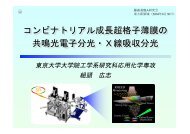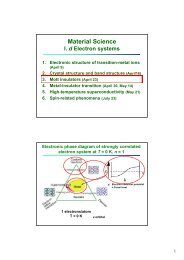Thesis High-Resolution Photoemission Study of Kondo Insulators ...
Thesis High-Resolution Photoemission Study of Kondo Insulators ...
Thesis High-Resolution Photoemission Study of Kondo Insulators ...
You also want an ePaper? Increase the reach of your titles
YUMPU automatically turns print PDFs into web optimized ePapers that Google loves.
8.4. Summary 123<br />
temperature magnetic susceptibility4 <strong>of</strong> FeSi1−xAlx would be helpful to understand the<br />
photoemission spectra on the energy scale higher than the (pseudo)gap.<br />
Finally, we compare the present result with that <strong>of</strong> Fe1−xCoxSi. In contrast with<br />
the spectral DOS <strong>of</strong> Fe1−xCoxSi, where the temperature-dependent depression on cooling<br />
from 295 K to 18 K survives almost fully in the x = 0.10 sample, the depression<br />
appears more sensitive to the Al substitution than the Co substitution although the<br />
electrical resistivity <strong>of</strong> Fe1−xCoxSi is almost the same as that <strong>of</strong> FeSi1−xAlx [8.8]. Surviving<br />
pseudogap in Fe1−xCoxSi is remarkable because the Fe 3d states dominate the<br />
electronic structure around EF in FeSi and thus the Fe-site substitution may be expected<br />
to change the low-energy electronic states <strong>of</strong> FeSi to a larger extent than the<br />
Al-site substitution. The energy region where the pseudogap opens on cooling is ∼<br />
50 meV from EF , independent <strong>of</strong> a small substitution <strong>of</strong> both Al and Co. Under the<br />
present normalization, raising the temperature increases the spectral DOS in any energy<br />
position while a slight (x ≤ 0.05) Al substitution at low temperature increases the<br />
spectral DOS at EF and simultaneously decreases the DOS between − 30 meV and −<br />
300 meV.<br />
8.4 Summary<br />
We have studied the electronic states in FeSi1−xAlx by temperature-dependent photoemission<br />
measurements. In spite <strong>of</strong> its structureless line shape, the response <strong>of</strong> the<br />
photoemission spectrum <strong>of</strong> FeSi to temperature or substitution is different in different<br />
energy regions. The dip in the vicinity <strong>of</strong> EF (∼ −20 meV) is filled for a small amount<br />
<strong>of</strong> Al substitution or a small temperature increase. The pseudogap region (∼ −50<br />
meV) monotonously depends on the temperature and the Al substitution. The shoulder<br />
around ∼−100 meV, which is expected to correspond to the <strong>Kondo</strong> peak in a<br />
<strong>Kondo</strong> metal, depends on the Al substitution up to x = 0.30. The broad peak at ∼−<br />
400 meV is stable against both temperature and substitution.<br />
4 Ohno et al. [8.8] and DiTusa et al. [8.11, 10] measured the magnetic susceptibility <strong>of</strong> FeSi1−xAlx<br />
below room temperature.






